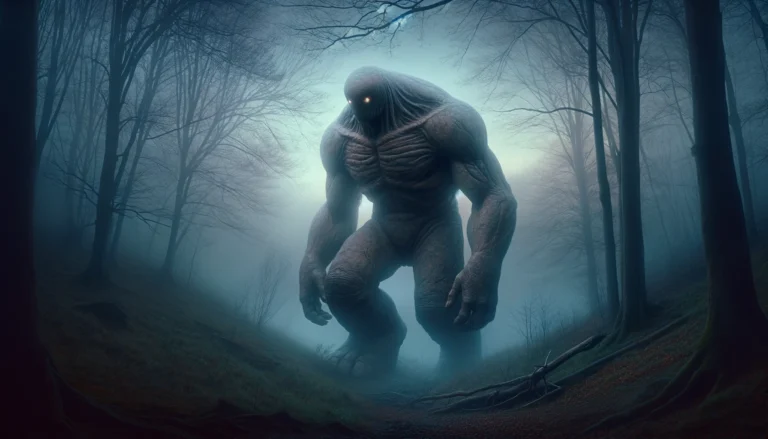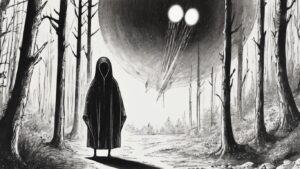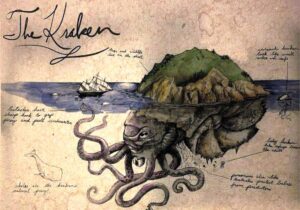Table of Contents
In the dense, shadowed forests of West Virginia, whispered tales linger of a creature so enigmatic and terrifying that it has sent shivers down the spines of even the most seasoned locals. This enigmatic entity, known as the Grafton Monster, has become a fixture of Appalachian folklore, its legend woven into the fabric of the region’s mysterious lore.
Origins
The origins of the Grafton Monster shroud in mystery, veiling its existence in the mists of Appalachian folklore. Though accounts vary, people often trace the creature’s genesis back to the rugged wilderness of West Virginia. Some speculate that it is the product of ancient Native American legends, a manifestation of primal fears and spiritual beliefs woven into the fabric of the land. Others suggest more recent origins, positing the Grafton Monster as a product of mutation or genetic aberration, born from the toxic legacy of industrialization that has scarred the region’s landscape.
Appearance
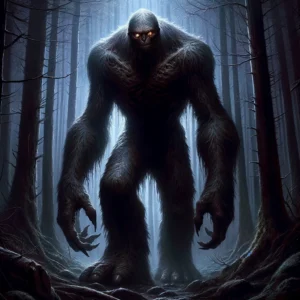
Observers often describe the Grafton Monster as a towering, humanoid figure, standing anywhere from seven to ten feet tall. Its body bears dark, matted fur, hanging in unkempt tufts along its massive frame. Additionally, the fur is coarse and tangled, adding to the creature’s wild and primal appearance.
Its head is large and elongated, with a pronounced brow ridge and a snout-like muzzle. Furthermore, glowing eyes, rumored to shine with an otherworldly luminescence, pierce the darkness of the forest. Witnesses often describe the eyes as glowing red or yellow, further adding to the creature’s eerie and unsettling presence.
The Grafton Monster’s limbs are long and powerful, with muscular arms ending in massive, clawed hands capable of inflicting great harm. Despite its large size, observers report that the Grafton Monster moves with surprising agility, navigating the forest with ease. Its gait, described as lumbering and heavy, proves swift when necessary.
Abilities
The abilities of the Grafton Monster remain largely speculative due to the elusive nature of the creature. However, according to folklore and reported encounters, it is rumored to possess:
Superhuman Strength: Capable of immense physical power, able to uproot trees and exhibit extraordinary force.
Agility: Observers report that despite its large size, the Grafton Monster moves with surprising agility, enabling it to navigate the forest with ease.
Stealth: Possesses an ability to vanish into the shadows, evading detection and disappearing without a trace.
Heightened Senses: Some accounts suggest heightened senses, allowing it to detect prey or threats from great distances.
Durability: Exhibits resilience to harm, with reports of surviving encounters with firearms and other weapons.
Territorial Instincts: Displays territorial behavior, fiercely guarding its domain from intruders.
Fear Inducement: Those who encounter it claim that its mere presence evokes a deep sense of dread and unease.
Weaknesses
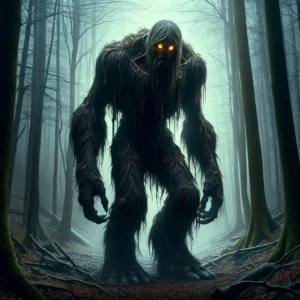
Reports and speculation also suggest potential weaknesses for the Grafton Monster, despite its shroud in mystery and legends.
Vulnerability to Light: Like many nocturnal creatures, the Grafton Monster may be sensitive to bright lights, which could disorient or repel it.
Limited Intelligence: Humans might exploit the creature’s cognitive limitations if it is more animalistic in nature.
Isolation: Disrupting its isolation or social structure could potentially weaken the Grafton Monster, given its solitary nature.
Environmental Factors: Changes in its natural habitat or disruptions to its ecosystem could impact its ability to thrive or survive.
Lack of Adaptability: The Grafton Monster may struggle to adapt to changes or new threats if it is highly specialized to its environment.
Size and Speed: Despite its reported strength and agility, the creature’s large size could potentially make it slower or less maneuverable in certain situations.
Predator-Prey Dynamics: If the Grafton Monster has natural predators or competitors in its ecosystem, exploiting these dynamics could weaken it.
Resource Limitations: Like any living creature, the Grafton Monster may have specific dietary or habitat requirements that, if disrupted, could weaken it over time.
Behavior with Humans
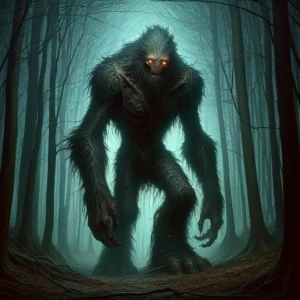
Encounters with the Grafton Monster are rare and fleeting, leaving little concrete evidence of its behavior with humans. However, based on reported sightings and anecdotal accounts, several themes emerge regarding its interactions with people:
Fear and Dread: Those who claim to have encountered the Grafton Monster often speak of an overwhelming sense of fear and dread in its presence. Its towering stature, menacing appearance, and eerie glowing eyes evoke primal instincts of danger and threat.
Avoidance: Describing the Grafton Monster as elusive and reclusive, it often prefers to avoid human contact whenever possible. It inhabits remote and densely forested areas, far from human settlements, retreating into the shadows to remain hidden from prying eyes.
Aggression: The Grafton Monster, generally regarded as a solitary creature, has displayed aggression towards humans who intrude upon its territory. Some witnesses claim the creature chased or threatened them, leading to harrowing encounters in the depths of the wilderness.
Curiosity: Despite its fearsome reputation, there are occasional reports of the Grafton Monster displaying curiosity towards humans. Some witnesses claim to have observed the creature watching them from a distance, its glowing eyes fixed upon them with an inscrutable gaze.
Legend and Lore: Moreover, the Grafton Monster has become a fixture of local folklore in West Virginia, with its legend passed down through generations of storytellers. It serves as a cautionary tale, reminding of the dangers in the wilderness, and fascinates those seeking to unravel its mysteries.
Related Myths and Stories
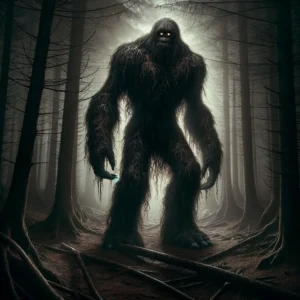
In the rugged wilderness of West Virginia, nestled among the dense forests and winding rivers, lurks a creature of shadow and legend. Known as the Grafton Monster, this elusive being is said to haunt the remote reaches of the Appalachian Mountains, its presence a whispered secret among the locals.
According to legend, the Grafton Monster is a relic of a bygone era, a primordial creature that has roamed the wilderness since time immemorial. Some believe it to be the product of ancient Native American legends, a manifestation of the spirits that dwell within the land.
According to legend, the Grafton Monster is a solitary and reclusive creature, favoring the solitude of the forest over human company. Its massive frame, cloaked in dark fur, moves silently through the shadows, with its glowing eyes piercing the darkness like twin beacons of dread.
Encounters with the Grafton Monster are rare and fleeting, leaving only scattered tales and whispered rumors in their wake. Some claim to have seen the creature lurking in the depths of the forest, its hulking form disappearing into the undergrowth before they could get a clear look.
Others speak of more harrowing encounters, of being chased through the woods by the creature’s thundering footsteps and blood-curdling cries. Whether real or imagined, these stories serve as a chilling reminder of the mysteries that lie beyond the edge of civilization.
Symbols Representing It
Though the Grafton Monster lacks the cultural ubiquity of other mythical creatures, its legend has nevertheless left an indelible mark on the folklore of West Virginia. In the small town of Grafton, where the creature is said to have earned its name, local residents have embraced its legacy, immortalizing it in art and storytelling. To some, the Grafton Monster serves as a symbol of the untamed wilderness, a reminder of the mysteries that lurk beyond the edge of civilization.
Similarities
Bigfoot/Sasquatch, perhaps the most famous cryptid in North American folklore, resembles a large, ape-like creature inhabiting remote forests. Bigfoot possesses immense strength, exhibits elusive behavior, and has a shaggy, humanoid appearance..
Similarly, the Yeti/Abominable Snowman, found in the Himalayas, gains renown as a legendary ape-like creature, known for its massive size, thick fur, and alleged sightings in remote mountain regions.
Likewise, the Yowie, an Australian cryptid, is said to inhabit dense forests and remote wilderness areas of the continent. Descriptions of the Yowie often mirror those of Bigfoot and the Grafton Monster, including reports of large size, shaggy fur, and a humanoid appearance.
Additionally, the Skunk Ape, native to the southeastern United States, is reported in swampy, wooded areas of Florida and neighboring states. Resembling a large, hairy ape.
Moreover, in Algonquian folklore, the Wendigo is a malevolent spirit or creature associated with the wilderness and cannibalism. While artists often depict it differently, they commonly portray it as a gaunt, emaciated figure with long limbs and glowing eyes, evoking a similar sense of dread.
FAQ
Where is the Grafton Monster said to inhabit?
Reports suggest it resides in remote and densely forested areas of West Virginia, far from human settlements.
What does the Grafton Monster look like?
It's described as standing 7 to 10 feet tall, with dark, matted fur, glowing eyes, and a humanoid appearance.
Are there any reported encounters with the Grafton Monster?
Yes, there have been sporadic sightings over the years, but concrete evidence remains elusive.
What abilities does the Grafton Monster possess?
Abilities are speculative, but it's rumored to have immense strength, agility, and a heightened sense of stealth.
Is the Grafton Monster dangerous?
A: Its behavior towards humans is uncertain, but encounters are often described as terrifying and accompanied by a sense of dread.
What are its weaknesses?
Weaknesses are speculative, but it may be vulnerable to light and disruptions to its environment.
Is the Grafton Monster real?
Its existence remains unconfirmed, with sightings attributed to folklore and urban legend.
